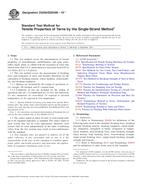We need your consent to use the individual data so that you can see information about your interests, among other things. Click "OK" to give your consent.
ASTM D2494-13
Standard Test Method for Commercial Mass of a Shipment of Yarn or Manufactured Staple Fiber or Tow
STANDARD published on 1.7.2013
The information about the standard:
Designation standards: ASTM D2494-13
Note: WITHDRAWN
Publication date standards: 1.7.2013
SKU: NS-20529
The number of pages: 6
Approximate weight : 18 g (0.04 lbs)
Country: American technical standard
Category: Technical standards ASTM
The category - similar standards:
Annotation of standard text ASTM D2494-13 :
Keywords:
commercial mass, textile fibers, textile strand, yarn, ICS Number Code 59.080.20 (Yarns)
Additional information
| Significance and Use | ||||||||||||||||||||||
|
5.1 This test method is considered satisfactory as a referee method for acceptance testing of commercial shipments of yarn or manufactured staple fibers. 5.1.1 If there are differences of practical significance between reported test results for two laboratories (or more), comparative tests should be performed to determine if there is a statistical bias between them, using competent statistical assistance. As a minimum, use the samples for such a comparative test that are as homogeneous as possible, drawn from the same lot of material as the samples that resulted in disparate results during initial testing and randomly assigned in equal numbers to each laboratory. The test results from the laboratories involved should be compared using a statistical test for unpaired data, a probability level chosen prior to the testing series. If a bias is found, either its casuse must be found and corrected, or future test results for that material must be adjusted in consideration of the known bias. 5.2 Option I is in common use in other countries, particularly in Europe.4 5.3 Option II is used to calculate the commercial mass of as-produced manufactured filament yarns (except some producer-textured yarns), manufactured staple fibers, and tows. This option is intended to reflect the mass of fiber remaining after fiber lubricants and processing aids are removed. 5.4 Option III is used to calculate the commercial mass of spun yarns, textured yarns, tops, and slivers. When materials are sold on a CMRU basis, the purchaser pays for the fiber lubricant or other removable processing aids. 5.5 Option IV is in common use with impregnated aramids. 5.6 When it can be shown that solvent extraction or another method of testing gives the same results, or results that have a constant ratio to those obtained by the scour procedure, that method may be used for routine testing of known production but should not be substituted for a scour on new or unknown material. For the determination of extractable matter, refer to Test Method D2257. 5.6.1 When the finish is not removable by a water scour, a solvent extraction may be substituted on agreement between the purchaser and the supplier. 5.7 Under certain circumstances, samples taken from yarns and manufactured staple fibers and tows can change moisture content rapidly. For this reason, very careful planning and handling of samples are required to prevent major biases in commercial mass results. |
||||||||||||||||||||||
| 1. Scope | ||||||||||||||||||||||
|
1.1 This test method provides a measurement of the commercial mass of a shipment of yarn or manufactured staple fiber or tow. This test method applies to (1.1.1 Sampling in this test method is primarily for use in acceptance testing rather than production control. manufactured fiber producers usually sample for the commercial “mass” of product on an on-going basis rather than each shipment to a customer. 1.2 Commercial mass has been traditionally based on one of three options depending on the state of the material: (1) dried, unscoured yarn, staple fiber, tow, and so forth, using commercial moisture regain in the calculations; (2) dried, scoured yarn, staple fiber, tow, and so forth, using commercial moisture regain values in the calculations; and (3) dried, scoured yarn, staple fiber, tow, and so forth, using a defined allowance in the calculations. 1.3 The values stated in SI units are to be regarded as standard. No other units of measurement are included in this standard. 1.4 This standard does not purport to address all of the safety concerns, if any, associated with its use. It is the responsibility of the user of this standard to establish appropriate safety and health practices and determine the applicability of regulatory limitations prior to use. |
||||||||||||||||||||||
| 2. Referenced Documents | ||||||||||||||||||||||
|
Similar standards:
Historical
1.7.2012
Historical
1.6.2010
Historical
1.7.2013
Historical
1.6.2010
Historical
1.2.2012
Historical
1.3.2012
We recommend:
Technical standards updating
Do you want to make sure you use only the valid technical standards?
We can offer you a solution which will provide you a monthly overview concerning the updating of standards which you use.
Would you like to know more? Look at this page.



 ASTM D1907/D1907M-12..
ASTM D1907/D1907M-12.. ASTM D204-02(2010)e1..
ASTM D204-02(2010)e1.. ASTM D2255/D2255M-09..
ASTM D2255/D2255M-09.. ASTM D2256/D2256M-10..
ASTM D2256/D2256M-10.. ASTM D2257-98(2012)..
ASTM D2257-98(2012).. ASTM D2258-99(2012)..
ASTM D2258-99(2012)..
 Cookies
Cookies
